Bright Colors Around The Lake

While keeping up on the loons, we are branching out further into the Pleasant Lake watershed. Today’s theme is “It pays to look closely as you walk about”.
Pearl is morphing rapidly now. As you can see below she is shedding some of her chick fluff for juvenile feathers. She is molting into plumage she will have for the next 2.5 years before becoming fully adult. We may soon see her taking practice flights on the lake.
To quote from a recent email by the rehabilitator: “Placido is doing great. The dozen live minnows disappeared in moments; I had turned around to empty the bucket, could hear the chase in the pool, and when I looked back Placido was underwater on the hunt. The water was turbulent, and he swallowed one fish as he went after another as best I could tell, not coming up for breath. When he did come up and the water calmed, I could see no minnows.”
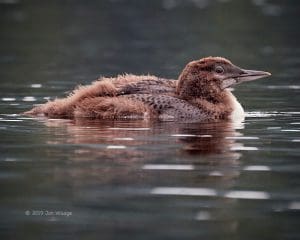
Walking on Lakeshore Drive, we saw a small patch of milkweed, just past the old barn and across from the entrance to the strawberry field. Let’s take a look. Hardly visible among the weeds, a patch of milkweed at the edge of the road begs for a look for monarch caterpillars. Check it out yourself if you are walking by!

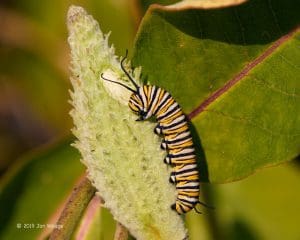
Monarch caterpillar munching on milkweed seed pod. As you probably know, milkweed sap is sticky and very toxic. It doesn’t take much to kill a cow or horse! Yet this is the caterpillar’s primary host plant. Herbivorous insects are very good at detoxifying or sequestering plant chemicals that are there to deter consumption. Little wonder that they quickly evolve resistance to most the the chemicals we invent to kill or deter them from our crops and gardens!
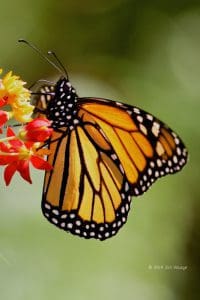
The orange, black and white of the caterpillar are present in the adult as well. The colors serve as a warning to potential predators – DO NOT EAT! Not only can monarchs deal with milkweed toxins, they sequester them into their bodies (including the wings of an adult) and become toxic to their own potential predators. Orange and black is a general signal in the animal world of something to be wary off. Think tigers, bees and wasps and coral snakes. Birds quickly learn to avoid monarchs. (the photo is from Florida but the butterfly milkweed grows here too.)
Monarchs are not the only insects that feed on milkweeds. So we searched for others. They are easy to find since they share a common trait with monarchs.

A milkweed bug (Oncopeltus fasciatus). They suck the sap from leaves and stems.

Milkweed beetles (Tetraopes tetrophthalmus) chew on the same leaves as monarch caterpillars.
Sadly, we could not find the bright orange aphids that also specialize on milkweeds. But, you get the picture, milkweed feeders share the orange and black warning system. Mimicry among “dangerous” animals is called Müllerian mimicry and the milkweed gang is one of the more famous examples.
A key point of showing you all of this is that even a small patch of milkweed can be a vital home to one of the most amazing migrators on the planet, the monarch butterfly. These butterflies are endangered from Canada to Peru because of pesticide use and habitat loss. We hear about forests where they overwinter being cut in Mexico, but we don’t hear enough about the general loss of milkweed across America. Anyone who raises livestock doesn’t want it in their fields or their hay. Urban expansion is destroying milkweed habitat. But we can help, even on a small scale, by planting milkweed in a corner of our yard or in parks and open spaces.
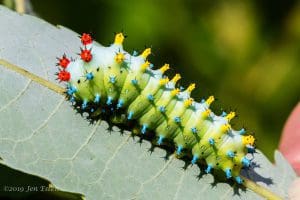
Here is another obvious caterpillar. We found it in some willows along the main trail in Esther Currier Wildlife Management Area at Low Plain. The water from that area, by the way, feeds into Pleasant Lake near Elkins. It is generally a bad idea to pick up any fuzzy caterpillar (stinging hairs) or anything that looks like this!
This ‘pillar becomes our largest native moth (5-7″ wing span) and one of most beautiful. Like all Saturnid silk moths, the adults lack moth parts or a digestive system and live only for a week or so on nutrients obtained as a caterpillar!
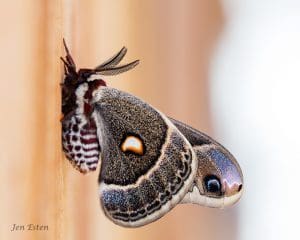
Cercropia moths (Hyalophora cecropia) are rarely seen but worth it when you do! Jen took this picture in Northern New Hampshire one evening.
Here are two more common local insects that are very obvious and share the orange and black warning coloration of monarchs, bees and wasps. But their mimicry is different! They are not at all nasty or dangerous to us. Look closely.

It is fuzzy but not a bumble bee. Count the wings – two. This fly, commonly called hoverflies or syrphid flies, gains some protection by mimicking a bumblebee (Batesian Mimicry). The wings are a giveaway. Flies are the only insects with two wings. You will find them in your yard just about anywhere in North America.

Not a wasp. Another hover fly. It even has a wasp waist, but the two wings say “fly”. Not only are these flies harmless to us, their larvae are major predators on aphids! So, these little mimics are great to have in our gardens.
It’s blueberry season! Time to beat the birds and chipmunks to the goodies! They are all along the lake shore and along roads and trails all around us.

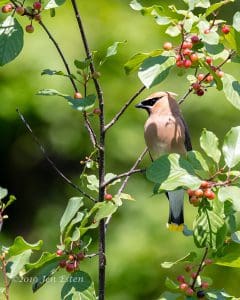
Another reason to look for bright berries – like these on shadbush – is a chance of glimpsing one of the more colorful birds in our area

Cedar Waxwing – more orange, yellow and black. They even seem to carry a bunch of berries on their wings. This and the previous photo are from Turtle Cove.
To be continued … Jon and Jen
